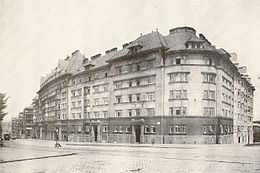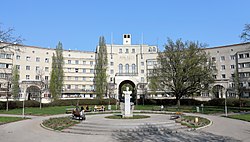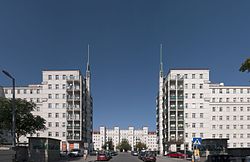Community building

As public housing is in Austria , especially in Vienna one, block of flats of the municipal social housing designated. Municipal housing has become an important part of the architecture and culture of Vienna since the 1920s .
history
Advance developments
Due to the wave of immigration from the crown lands of Austria-Hungary to Vienna , the population rose to over 2 million by 1910. As a result, the living situation of the working class was often determined by unreasonable living conditions. One consequence of this development was high rent. The apartments were overcrowded, i.e. H. the number of lodgers and " bed-goers " rose, and the housing misery got worse and worse.
Around 1900, the first approaches to municipal housing emerged in the form of company apartments . The work of newly established charitable foundations and associations was a second approach to alleviating misery.
The First World War slowed down all developments, so that in 1917 almost three quarters of all Vienna apartments were overcrowded one and two-room apartments. This year was kk government forced to take measures to ensure that families are not evicted from standing in the war soldiers because they could no longer pay the interest: a rent control ordinance with rent stop ( " Peace Interest ") and a restriction of the right of termination were created . With this, one of the essential prerequisites for later social housing was created - albeit rather unintentionally. (Tenant protection and peace rates for old apartments remained in effect for decades after the Second World War.)
Municipal housing of the First Republic
The Social Democratic Workers' Party , which ruled in the so-called Red Vienna during the First Republic (1918–1934), began a project to improve the living conditions for workers . Around 65,000 community apartments, mostly in large residential complexes, were built during this time. This was possible because the municipality of Vienna was able to acquire a large number of properties at affordable prices due to the lack of private demand due to the lack of private demand - such as the so-called " Drasche belt" in the south of the city, which stretched from Meidling to Kaiserebersdorf , or the " Frankl reasons ". The communal buildings were also exempt from taxes because they were not for profit.
When Vienna became an independent federal state from 1920 to 1922 , it also acquired tax sovereignty for state taxes. For example, Hugo Breitner, City Councilor for Finance, appointed by Mayor Jakob Reumann in 1919, was able to lay the basis for the municipal housing program with the purpose-built housing tax that was decided on at his suggestion in 1923. The housing tax had to be paid by all owners of rentable rooms, but staggered in such a way that the most expensive 0.5% of the properties provided 44.5% of the total tax payment.
The main goal of Viennese municipal housing construction was the construction of residential complexes that enabled healthy living conditions for their residents. Including the objects completed after 1934, 65,000 apartments with living space for around 220,000 residents were built in 382 municipal buildings. The apartments were awarded according to a point system that favored families and low-income citizens.
“ When we are no more, these stones will speak for us. "
During this time, the classic municipal housing in Red Vienna was built:
- Lassalle-Hof (2nd district)
- Rabenhof (3rd district)
- Metzleinstaler Hof (5th district, the first community building 1919–1920)
- Reumannhof (5th district)
- Victor-Adler-Hof (10th district)
- George Washington Hof (10th and 12th District)
- Sandleitenhof (16th district; the largest complex with 1,587 apartments)
- Karl-Marx-Hof (19th district; 1,325 apartments)
- Friedrich-Engels-Platz residential complex (20th district; 1,467 apartments)
- Karl-Seitz-Hof (21st district, 1,173 apartments)
- Paul-Speiser-Hof (21st district, 469 apartments)
- Goethehof (today 22nd district, 727 apartments)
Lassalle-Hof , main entrance and business premises on Lassallestrasse
(1924–1926)Street courtyard of the Reumannhof in the 5th district (1924–1926)
Karl-Seitz-Hof in Floridsdorf (1926–1933)
Housing complex Friedrich-Engels-Platz in Brigittenau (1930–1933)
In the four other larger cities in Austria, too, many community buildings were built over the years. Examples include Salzburg Lehen , Linz Urfahr , Innsbruck Wilten and Graz Triester Siedlung .
The contemporary conservative criticism suspected Viennese council were fortress sartig been designed, which did not correspond to the facts. The architecture merely expressed the self-confidence of the Social Democrats ruling Vienna, occasionally in a form that seems pathetic today. During the February fighting in 1934 , many municipal buildings in Vienna were attacked by the Heimwehr and the armed forces and defended by the Republican Protection Association . This happened, for example, in the Karl-Marx-Hof , the third largest and most famous municipal housing in Vienna, which was badly damaged in the fighting, or in the Goethehof, which was shot at with cannons across the Danube. The reason for these fighting was the fact that many supporters of democracy lived in the community buildings, who had organized themselves in the Schutzbund to defend themselves against fascist currents and who did not want to submit to the dictatorship without defenselessness.
The stagnation 1934–1945
When the Austrofascists came to power in 1934, the building activity of Red Vienna largely ceased. During the years of the Nazi dictatorship between 1938 and 1945 , the available funds were mostly diverted to the armaments industry .
At the end of the war in 1945, around 13% of the entire Vienna housing stock had been destroyed. The damaged community buildings were subsequently repaired, so that all 382 community buildings from the interwar period still exist today.
Municipal housing since 1945
After the end of the war, the damage to the buildings first had to be repaired; after all, every sixth community apartment was destroyed or unusable. In 1947, the City of Vienna resumed residential construction with the Per-Albin-Hansson West housing estate, built from rubble brick . In addition, the destroyed or badly damaged buildings were rebuilt by the end of the 1950s. Due to the tax exemption of the non-profit building associations in the context of non-profit housing and the associated privileged access to subsidies for housing, more than 80% of the apartment buildings were built in this context.
The architectural style adapted to the respective time, for example in the construction of high-rise buildings or in the line arrangement due to the scarcity of building land. This type of communal residential building from the reconstruction period is characterized by a very simple facade design (criticized a little later as "Emmental architecture", but today it often appears pleasantly simple). Back then it was important to build as much living space as possible in a short time. In 1950 alone there were 55,248 people looking for accommodation, 31,309 of them of the highest level of urgency. By 1970, 96,000 apartments had been created in this way.
In the 1960s, typical high-rise settlements were built using prefabricated elements, such as the Großfeldsiedlung in Leopoldau or the Am Schöpfwerk settlement (1967–1980). In the 1970s, multi-storey megastructures were mainly realized, with preference given to building terraced residential complexes such as on the Trabrenngrund (1973–1977) with 2,437 apartments. This was also a period of urban development on areas previously unused for residential construction, which began again on a large scale, especially in the years after 2000.
Since the social problem of such large-scale systems was soon recognized, municipal housing in the following years shifted more and more towards the closure of vacant lots, urban renewal projects, residential building renovation and compact low-rise buildings. Later, however, this was no longer sufficient, which is why large-scale urban expansion projects were tackled again, especially after the year 2000. In 2012 social housing became very active again in projects such as the Seestadt Aspern , the Nordbahnhof area and the Sonnwendviertel on the area of the former freight station Wien Süd.
The Viennese city administration itself now often limited itself to the planning and funding of new residential complexes: The last municipal building for fifteen years was built in 2004 in Rößlergasse in the 23rd district. In view of their own housing stock, which is very large even in an international comparison of cities, the city administration no longer wanted to carry out social housing projects itself as the builder or lessor. At the start of the 2015 election campaign (state and municipal council elections), however , Mayor Michael Häupl announced the construction of further municipal buildings. In November 2019 , another new community building was opened with the Barbara-Prammer-Hof in Favoriten , and more are being built or are in planning.
Today the city of Vienna owns around 220,000 council flats and is therefore the largest property management company in Europe. The administration is carried out by the public company Wiener Wohnen , which forms part of the City of Vienna's magistrate . Around 500,000 people live in over 2,300 community buildings, around a quarter of all residents of Vienna.
features

In the case of communal apartments, in contrast to cooperative apartments , the communes themselves act as builders and landlords. Typically, municipal housing was more present in municipalities dominated by social democrats, while cooperatives were more active in municipalities attributable to the ÖVP .
The classic community buildings from the interwar period are typically built in perimeter blocks. On the relatively splendid front side, a large entrance gate leads into a courtyard that is designed as a green area with playgrounds . The apartments are accessed from the inner courtyard via various (numbered) staircases. Because of the often opulently designed entrances, the style of the communal buildings is also jokingly called “workers baroque”.
The Gemeindebauanlagen verfüg (t) s often facilities such as Municipal Library , Kindertagesheim , laundry facilities, an auditorium, a children's pool , indoor pool , health centers or malls. Prime examples of mega residential complexes with many additional offers are the Sandleitenhof in the 16th (over 4000 residents), the Karl-Marx-Hof in the 19th and the Rabenhof in the 3rd district.
The building owner and source of finance were written conspicuously on the systems from this time. B. by means of an inscription on the facade with the text Housing complex of the municipality of Vienna, built between 1925 and 1927 from the funds of the housing tax .
Many municipal buildings have names, in addition to some geographical names, mainly personal names. In addition to celebrities like Haydn , George Washington , Goethe , Heinrich Heine , Robert Blum , Theodor Herzl , Strindberg , Freud , Einstein , Bertha von Suttner and Richard Strauss , well-known socialists and social democrats like Karl Marx , Friedrich Engels , Ferdinand Lassalle were in the Red Vienna , Karl Liebknecht , Friedrich Ebert , Victor Adler and Jean Jaurès honored. Since 1945, politicians like Per Albin Hansson , George Marshall , Dag Hammarskjöld and Olof Palme and other celebrities like Frédéric Chopin , Arthur Schnitzler , Oskar Werner , Helmut Qualtinger , Viktor Frankl and Friedensreich Hundertwasser joined them, as well as little-known people who were active in the respective district Politician.
Churches
The Unterheiligenstädter parish church was added to the Karl-Marx-Hof in 1934 , analogous to the Karl-Seitz-Hof the parish church Gartenstadt , which still shows the original name Gartenstadt of the courtyard. At the Heinz-Nittel-Hof , the Markuskirche was already part of the planning during the draft. The Am Schöpfwerk church on the edge of the Am Schöpfwerk large residential complex was designed like this by the architect Viktor Hufnagl .
From 1977 to 1981 three multi-purpose ecclesiastical halls were built in Floridsdorf and the Donaustadt , the parish church of St. Christoph on Rennbahnweg near the Trabrenngrund , the pastoral care station of St. Michael near the Dr.-Koch-Hof and the parish church of St. Claret-Ziegelhof in Quadenstrasse near Municipal housing at Ziegelhofstrasse.
See also
- List of municipal housing in Vienna (overview page for the lists of the individual districts)
- Suburban settlement (Austria)
- Hitler buildings
- South Tyrolean settlement
literature
- chronological -
- Hans Hautmann , Rudolf Hautmann : The municipal housing of the Red Vienna , Schönbrunn Verlag, Vienna 1980.
- Albert Lichtblau : Vienna Housing Policy 1892–1919. Publishing house for social criticism , Vienna 1984, ISBN 3-900351-33-3 .
- Hans Schafranek : “We were the leaders” - militancy and resignation in February 1934 using the example of Kaisermühlen. In: Helmut Konrad , Wolfgang Maderthaner (eds.): Recent studies on workers' history , Vol. II: Contributions to political history , Europaverlag, Vienna 1984, ISBN 3-203-50895-8 , pp. 439-469.
- Erich Bramhas: The Viennese municipal housing: From Karl-Marx-Hof to Hundertwasserhaus . Birkhäuser, Basel 1987, ISBN 3-7643-1797-3 .
- Helmut Weihsmann : The red Vienna. Social democratic architecture and local politics 1919 - 1934. (= Edition traces .) 1st edition 1985; 2nd, completely revised edition, Promedia, Vienna 2002, ISBN 978-3-85371-181-1 , table of contents.
- Wolfgang Förster, Gabriele Kaiser, Dietmar Steiner , Alexandra Viehhauser: Housing in Vienna: Innovative. Social. Ecologically. Book for the exhibition of the same name 2009, Architekturzentrum Wien (Ed.), Vienna 2008.
- Florian Bettel, Julia Mourão Permoser, Sieglinde Rosenberger (eds.): Living rooms - politics of affiliations in municipal housing in Vienna. Springer Verlag, Vienna / New York 2012, ISBN 978-3-7091-1224-3 , online file.
- Harald A. Jahn : The miracle of Red Vienna. Volume I: Between the Economic Crisis and Art Deco . Phoibos-Verlag, Vienna 2014, ISBN 978-3-85161-075-8 .
- Harald A. Jahn: The miracle of Red Vienna. Volume II: From the housing tax funds . Phoibos-Verlag, Vienna 2014, ISBN 978-3-85161-076-5 .
Theater in municipal housing
- About the so-called GemeindeHOFtheater: Gabriele C. Pfeiffer: Come here! Free entry. The Dario Fo theater in the working class districts. Mandelbaum, Vienna 2009, ISBN 978385476-300-0 .
Movies
- Municipal housing - an institution makes history. Part 1: From the city wall to the community castle. Documentary with archive recordings, Austria, 2018, 45:30 min., Script and director: Wolfgang Winkler, production: Pammer Film, ORF , series: zeit.geschichte , first broadcast: March 3, 2018 on ORF III , table of contents with preview by ORF, online video from ORF.
- Municipal housing - an institution makes history. Part 2: Phoenix from the ashes. Documentary with archive footage, Austria, 2018, 45:30 min., Script and director: Wolfgang Winkler, production: Pammer Film, ORF , series: zeit.geschichte , first broadcast: March 3, 2018 on ORF III.
- Housing culture in Vienna - from the early days to community housing. Documentary with archival footage, Austria, 2013, 43:41 Min, written and directed. Rosa Maria Plattner, production: steko film, ORF, Summary of ARD . Municipal housing from 14:23 min., Discussions on the occasion of the permanent exhibition Das Rote Wien in the laundromat Karl-Marx-Hof , u. a. with Friedrich Achleitner , Lilli Bauer, Werner T. Bauer , Katharina Prantl .
Web links
- Wiener Wohnen - community flats. In: Wiener Wohnen . The largest municipal property management company in Europe
- Vienna cultural property - city map of all municipal housing. In: City of Vienna
- Wiener Gemeindebau - historical - tabular chronology. ( Memento of July 5, 2012 in the Internet Archive ). In: City of Vienna
- Social housing in Vienna. 80 years of success and challenge. ( Memento from February 1, 2009 in the Internet Archive ). In: Viennese regional administration. An instrument for gentle, resident-oriented urban renewal.
Lexicons
- Municipal housing. In: dasrotewien.at - Web dictionary of the Viennese social democracy. SPÖ Vienna (Ed.)
- Entry on municipal housing in the Austria Forum (in the AEIOU Austria Lexicon )
- Municipal housing in the Vienna History Wiki of the City of Vienna
items
- Joseph Gepp: One city, two houses. In: Falter , 2009, No. 18
- Heidemarie Uhl : Life in Community Housing. ( Memento of October 22, 2007 in the Internet Archive ). In: Democracy Center Vienna, 2/2006
- Vienna - worth seeing. Municipal housing. In: suf.at , undated. , With illustrations
Individual evidence
- ↑ Alexander Music: Karl-Marx-Hof: My home, my castle. In: Frankfurter Rundschau . January 21, 2009, accessed March 16, 2018 .
- ↑ Helmut Weihsmann , Das Rote Wien - Social Democratic Architecture and Local Policy 1919–1934 , Promedia, Vienna 2002, ISBN 3-85371-181-2 , p. 120.
- ^ Jan Kuhnert , Olof Leps: The non-profit housing in Austria . In: New non-profit housing . Springer Fachmedien, Wiesbaden 2017, ISBN 978-3-658-17569-6 , pp. 179–186 , doi : 10.1007 / 978-3-658-17570-2_6 ( springer.com [accessed February 28, 2017]).
- ↑ Häupl: 2000 new community apartments . In: Vienna. orf.at , February 26, 2015.
- ↑ First new community building completed. In: wien.orf.at . November 5, 2019, accessed November 5, 2019.
- ↑ Traveling exhibition through Vienna: “I live in municipal housing!” ( Memento from March 9, 2005 in the Internet Archive ), exhibition opening on January 24, 2005.
- ^ The Red Vienna in the laundromat Karl-Marx-Hof. In: Waschsalon im Karl-Marx-Hof , accessed on April 28, 2020.






